Abstract
Our previous cerebral ultrasound study of antecedents of periventricular haemorrhage in infants weighing 1250 g or less at birth suggested that neonatal events that caused increased or fluctuating cerebral blood flow lead to periventricular haemorrhage. As the risk period for this type of haemorrhage was the first four days of life strict guidelines were introduced to avoid the previously identified neonatal risk factors. No attempt was made to modify obstetric practice. Over the next two years, although the obstetric risk profile, the frequency and severity of hyaline membrane disease, and the gestation, birth weight, and sex distributions of a similar cohort of infants did not change, the incidence of periventricular haemorrhage decreased significantly from 60% to 36%. Significant antecedents of haemorrhage similar to those found in the previous study included severe bruising, low arterial:fractional inspiratory oxygen ratio and low packed cell volume on admission, hyaline membrane disease, hypercarbia, and hypoxaemia. Assisted ventilation, pneumothorax, treatment with tubocurarine, and hypotension were no longer significant risk factors for periventricular haemorrhage. A multivariate discriminant analysis correctly predicted haemorrhage in 86% of the study group when bruising, hypercarbia, hypoxaemia, hyaline membrane disease, and low gestation were considered. These results suggest that changes in neonatal practices can reduce the incidence of periventricular haemorrhage and that drug studies indicating similar reduction in haemorrhage need to be evaluated carefully to ensure that placebo and treated groups are in fact comparable.
Full text
PDF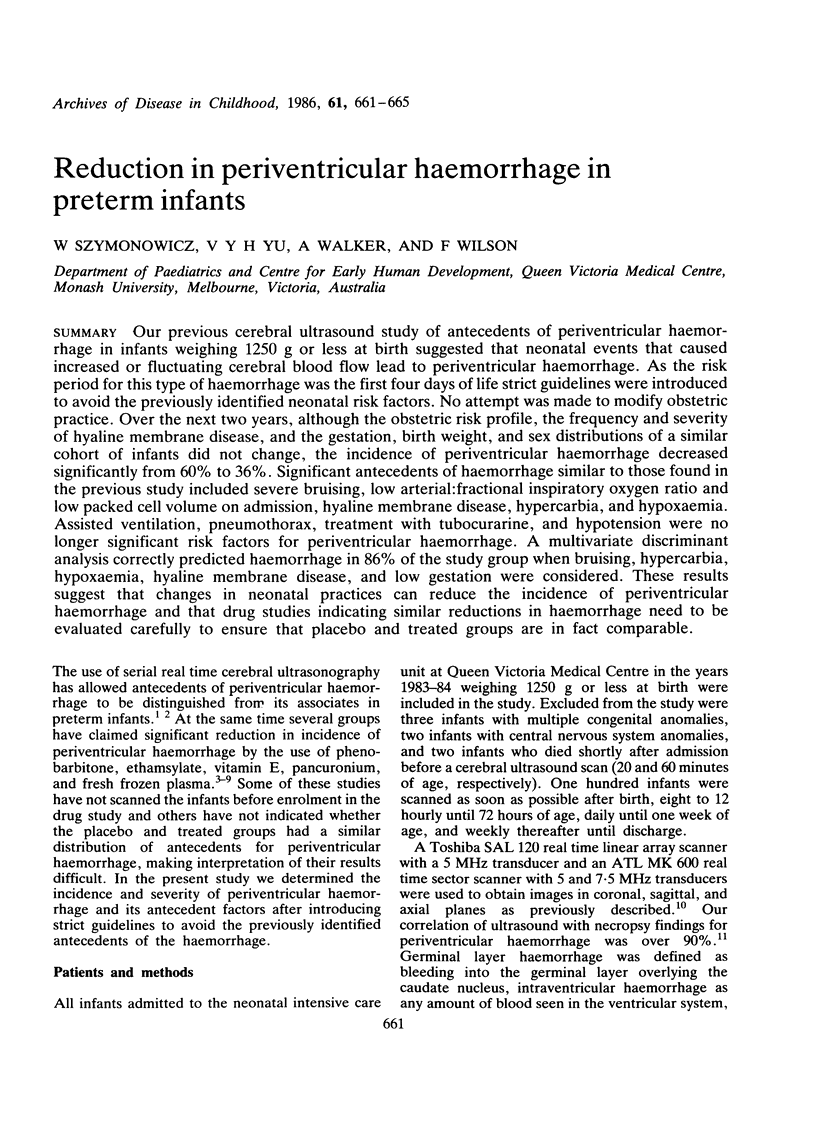
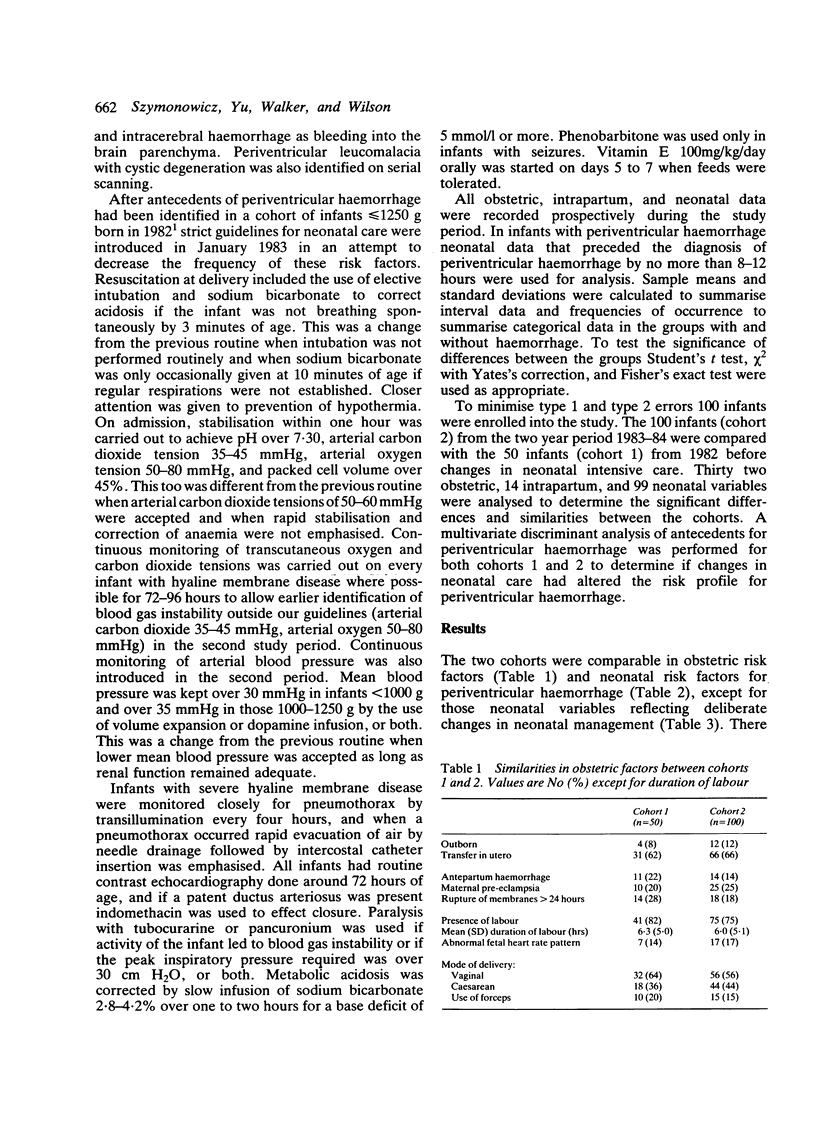
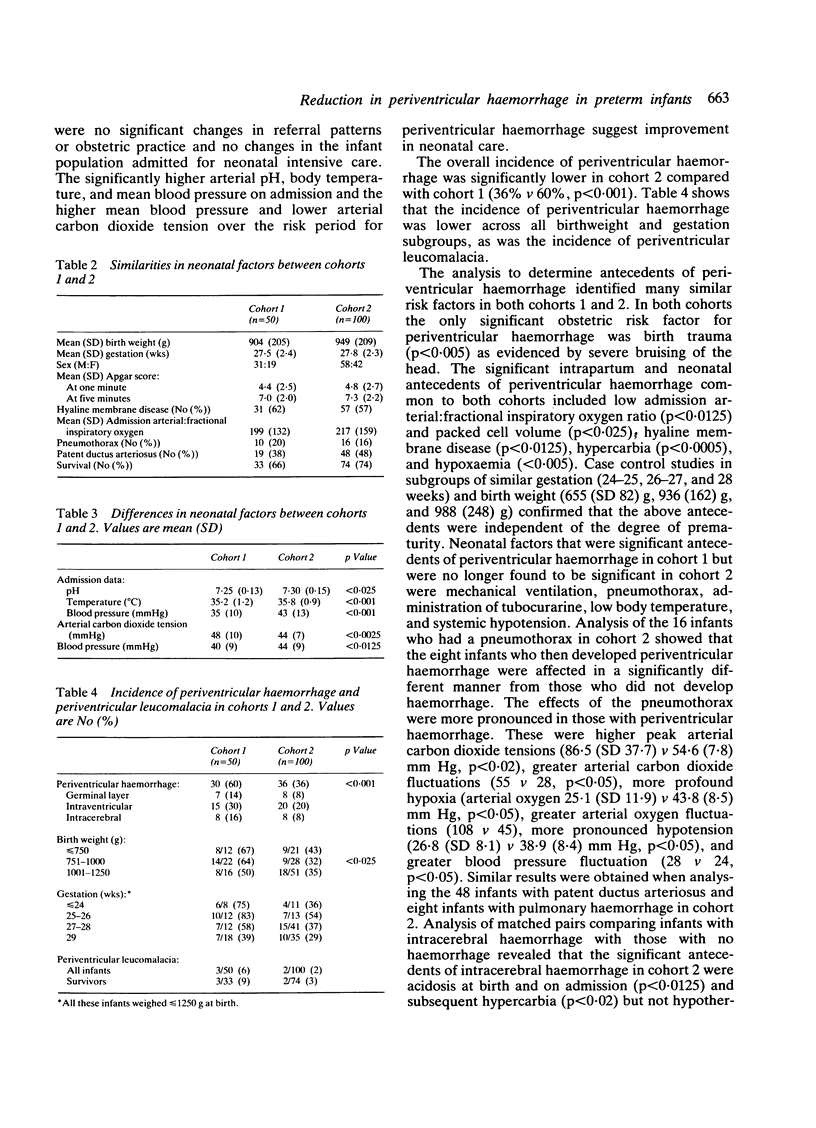
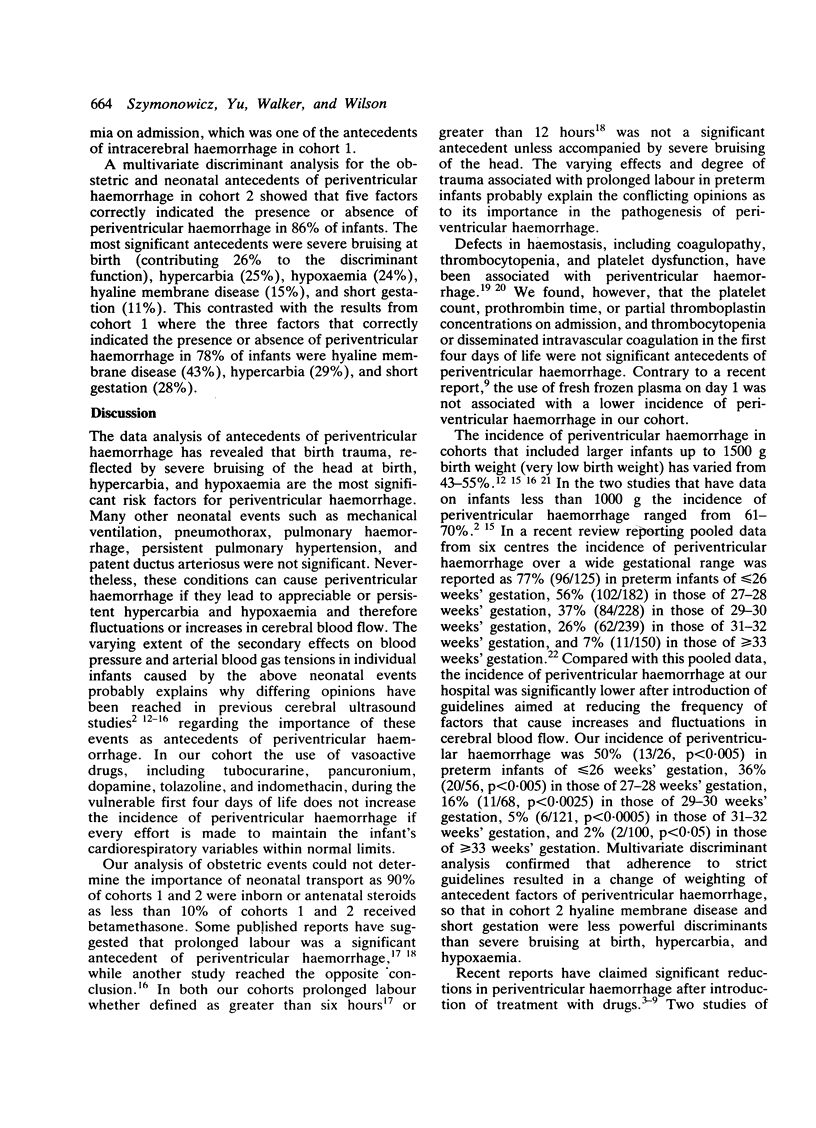
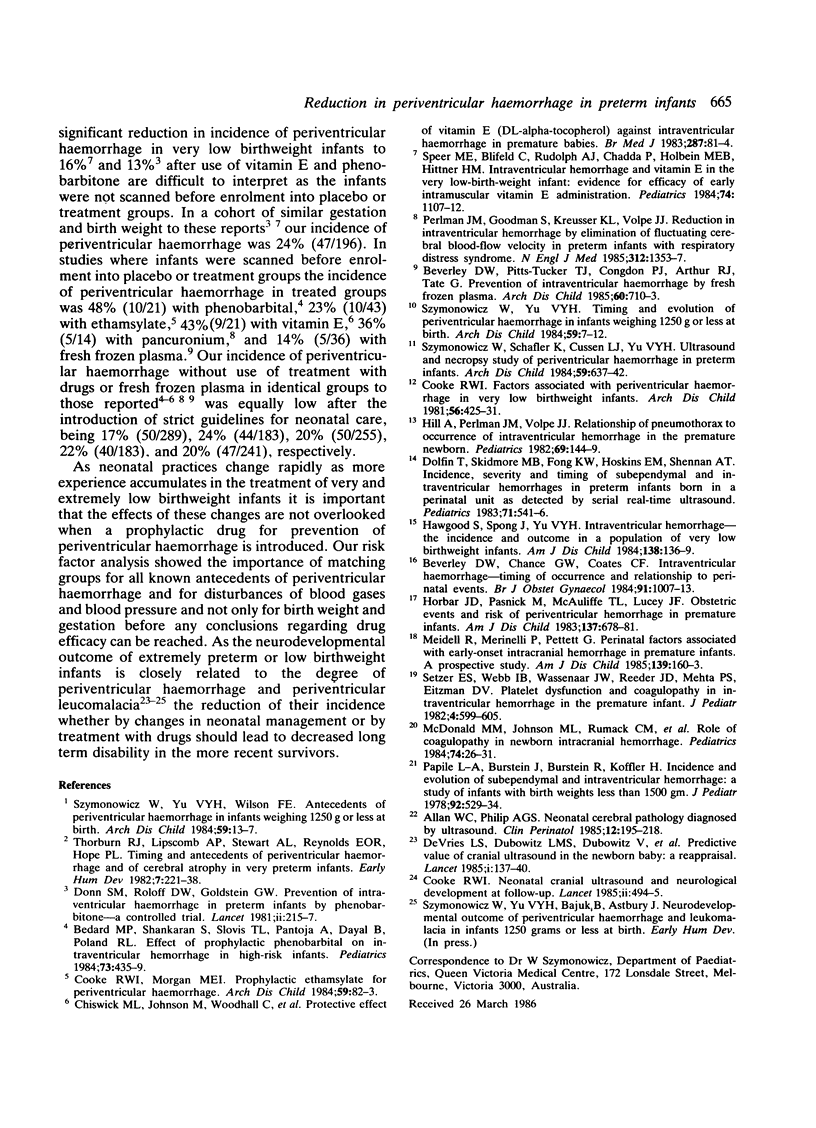
Selected References
These references are in PubMed. This may not be the complete list of references from this article.
- Allan W. C., Philip A. G. Neonatal cerebral pathology diagnosed by ultrasound. Clin Perinatol. 1985 Feb;12(1):195–218. [PubMed] [Google Scholar]
- Bedard M. P., Shankaran S., Slovis T. L., Pantoja A., Dayal B., Poland R. L. Effect of prophylactic phenobarbital on intraventricular hemorrhage in high-risk infants. Pediatrics. 1984 Apr;73(4):435–439. [PubMed] [Google Scholar]
- Beverley D. W., Chance G. W., Coates C. F. Intraventricular haemorrhage--timing of occurrence and relationship to perinatal events. Br J Obstet Gynaecol. 1984 Oct;91(10):1007–1013. doi: 10.1111/j.1471-0528.1984.tb03679.x. [DOI] [PubMed] [Google Scholar]
- Beverley D. W., Pitts-Tucker T. J., Congdon P. J., Arthur R. J., Tate G. Prevention of intraventricular haemorrhage by fresh frozen plasma. Arch Dis Child. 1985 Aug;60(8):710–713. doi: 10.1136/adc.60.8.710. [DOI] [PMC free article] [PubMed] [Google Scholar]
- Chiswick M. L., Johnson M., Woodhall C., Gowland M., Davies J., Toner N., Sims D. G. Protective effect of vitamin E (DL-alpha-tocopherol) against intraventricular haemorrhage in premature babies. Br Med J (Clin Res Ed) 1983 Jul 9;287(6385):81–84. doi: 10.1136/bmj.287.6385.81. [DOI] [PMC free article] [PubMed] [Google Scholar]
- Cooke R. W. Factors associated with periventricular haemorrhage in very low birthweight infants. Arch Dis Child. 1981 Jun;56(6):425–431. doi: 10.1136/adc.56.6.425. [DOI] [PMC free article] [PubMed] [Google Scholar]
- Cooke R. W., Morgan M. E. Prophylactic ethamsylate for periventricular haemorrhage. Arch Dis Child. 1984 Jan;59(1):82–83. doi: 10.1136/adc.59.1.82. [DOI] [PMC free article] [PubMed] [Google Scholar]
- Cooke R. W. Neonatal cranial ultrasound and neurological development at follow-up. Lancet. 1985 Aug 31;2(8453):494–495. doi: 10.1016/s0140-6736(85)90417-9. [DOI] [PubMed] [Google Scholar]
- Dolfin T., Skidmore M. B., Fong K. W., Hoskins E. M., Shennan A. T. Incidence, severity, and timing of subependymal and intraventricular hemorrhages in preterm infants born in a perinatal unit as detected by serial real-time ultrasound. Pediatrics. 1983 Apr;71(4):541–546. [PubMed] [Google Scholar]
- Donn S. M., Roloff D. W., Goldstein G. W. Prevention of intraventricular haemorrhage in preterm infants by phenobarbitone. A controlled trial. Lancet. 1981 Aug 1;2(8240):215–217. doi: 10.1016/s0140-6736(81)90470-0. [DOI] [PubMed] [Google Scholar]
- Hawgood S., Spong J., Yu V. Y. Intraventricular hemorrhage. Incidence and outcome in a population of very-low-birth-weight infants. Am J Dis Child. 1984 Feb;138(2):136–139. doi: 10.1001/archpedi.1984.02140400022005. [DOI] [PubMed] [Google Scholar]
- Hill A., Perlman J. M., Volpe J. J. Relationship of pneumothorax to occurrence of intraventricular hemorrhage in the premature newborn. Pediatrics. 1982 Feb;69(2):144–149. [PubMed] [Google Scholar]
- Horbar J. D., Pasnick M., McAuliffe T. L., Lucey J. F. Obstetric events and risk of periventricular hemorrhage in premature infants. Am J Dis Child. 1983 Jul;137(7):678–681. doi: 10.1001/archpedi.1983.02140330062017. [DOI] [PubMed] [Google Scholar]
- McDonald M. M., Johnson M. L., Rumack C. M., Koops B. L., Guggenheim M. A., Babb C., Hathaway W. E. Role of coagulopathy in newborn intracranial hemorrhage. Pediatrics. 1984 Jul;74(1):26–31. [PubMed] [Google Scholar]
- Meidell R., Marinelli P., Pettett G. Perinatal factors associated with early-onset intracranial hemorrhage in premature infants. A prospective study. Am J Dis Child. 1985 Feb;139(2):160–163. doi: 10.1001/archpedi.1985.02140040058028. [DOI] [PubMed] [Google Scholar]
- Papile L. A., Burstein J., Burstein R., Koffler H. Incidence and evolution of subependymal and intraventricular hemorrhage: a study of infants with birth weights less than 1,500 gm. J Pediatr. 1978 Apr;92(4):529–534. doi: 10.1016/s0022-3476(78)80282-0. [DOI] [PubMed] [Google Scholar]
- Perlman J. M., Goodman S., Kreusser K. L., Volpe J. J. Reduction in intraventricular hemorrhage by elimination of fluctuating cerebral blood-flow velocity in preterm infants with respiratory distress syndrome. N Engl J Med. 1985 May 23;312(21):1353–1357. doi: 10.1056/NEJM198505233122104. [DOI] [PubMed] [Google Scholar]
- Setzer E. S., Webb I. B., Wassenaar J. W., Reeder J. D., Mehta P. S., Eitzman D. V. Platelet dysfunction and coagulopathy in intraventricular hemorrhage in the premature infant. J Pediatr. 1982 Apr;100(4):599–605. doi: 10.1016/s0022-3476(82)80766-x. [DOI] [PubMed] [Google Scholar]
- Speer M. E., Blifeld C., Rudolph A. J., Chadda P., Holbein M. E., Hittner H. M. Intraventricular hemorrhage and vitamin E in the very low-birth-weight infant: evidence for efficacy of early intramuscular vitamin E administration. Pediatrics. 1984 Dec;74(6):1107–1112. [PubMed] [Google Scholar]
- Szymonowicz W., Schafler K., Cussen L. J., Yu V. Y. Ultrasound and necropsy study of periventricular haemorrhage in preterm infants. Arch Dis Child. 1984 Jul;59(7):637–642. doi: 10.1136/adc.59.7.637. [DOI] [PMC free article] [PubMed] [Google Scholar]
- Szymonowicz W., Yu V. Y. Timing and evolution of periventricular haemorrhage in infants weighing 1250 g or less at birth. Arch Dis Child. 1984 Jan;59(1):7–12. doi: 10.1136/adc.59.1.7. [DOI] [PMC free article] [PubMed] [Google Scholar]
- Szymonowicz W., Yu V. Y., Wilson F. E. Antecedents of periventricular haemorrhage in infants weighing 1250 g or less at birth. Arch Dis Child. 1984 Jan;59(1):13–17. doi: 10.1136/adc.59.1.13. [DOI] [PMC free article] [PubMed] [Google Scholar]
- Thorburn R. J., Lipscomb A. P., Stewart A. L., Reynolds E. O., Hope P. L. Timing and antecedents of periventricular haemorrhage and of cerebral atrophy in very preterm infants. Early Hum Dev. 1982 Dec 6;7(3):221–238. doi: 10.1016/0378-3782(82)90085-8. [DOI] [PubMed] [Google Scholar]


